You are going to please your guests with delicious Parmesan or delicate Dor Blue. But then a problem arises - how to cut the product into beautiful slices? The task cannot be completed without a special knife for cutting cheese . Its unusual shape and design allows you to create neat portions without damaging the texture. Get to know the features and types of tools to choose the right option for your kitchen.
Types of cheese knives
Texture is just as important to dairy products as flavor. We invariably imagine mozzarella to be tender and maasdam to be smooth and moist. You won’t be able to preserve the texture of the cheese pulp as much as possible with an ordinary kitchen knife; you need special tools.
But cheese varieties vary greatly in hardness, so there is no universal cutting device. In culinary practice, tools of different designs are used, adapted to the texture and hardness of the product.
Classic cheese knives
The product is easily recognized by its massive blade with holes. The edge of the blade is equipped with teeth, like a saw. The handle should be level with the blade. This arrangement prevents your fingers from colliding with the cutting board.
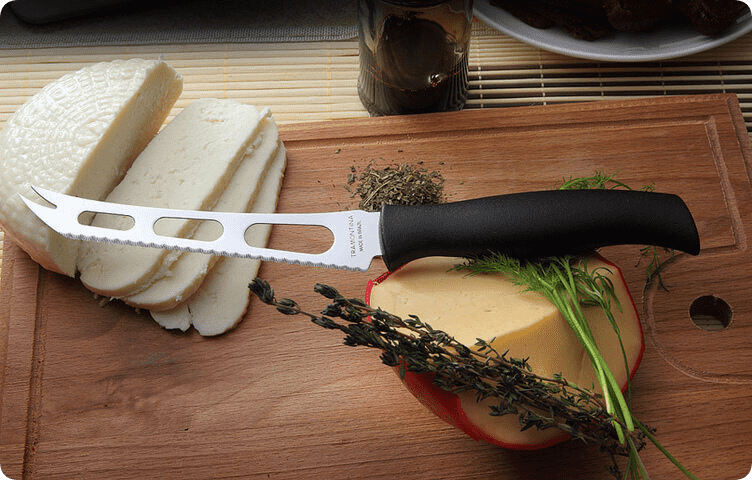
The shape of the tool helps you effortlessly cut the product into even slices or cubes. The product is suitable for semi-hard grades including:
- gouda;
- edam;
- Russian;
- Cheddar;
- Tilsiter.
The classic tool is often forked at the tip so that it can be used like a fork.
Lever
This device looks like a board on a stand with a cutter attached to it. To get neat slices, a piece of cheese is placed on a board and cut by lowering the cutter by the handle. This convenient device is suitable for cutting hard and semi-hard cheeses, as well as ham and sausage.
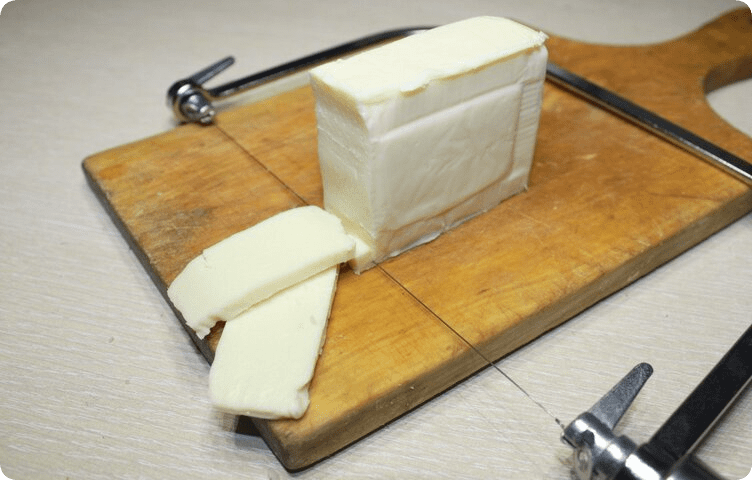
Knife with two handles
The product is a straight or arched blade, both ends of which are equipped with handles. By pressing both handles at once, you can easily cut a large piece or wheel of cheese. In different models of the tool, the handles can be located vertically or horizontally to the blade.
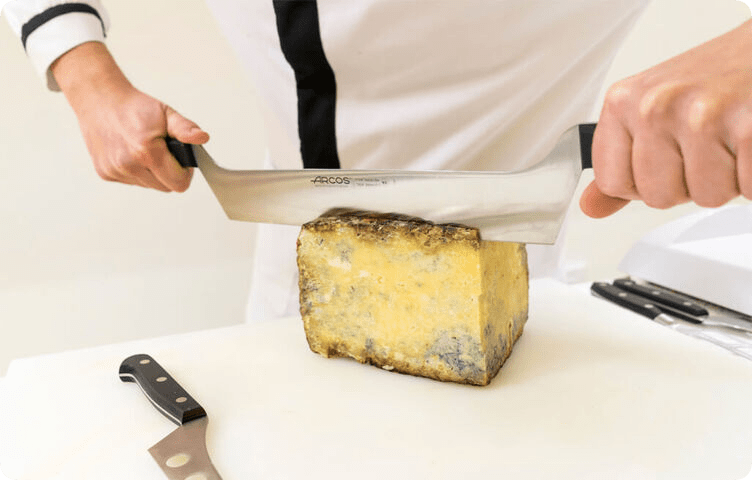
Blades for soft cheeses
The product with a delicate creamy texture is difficult to spread with either a spoon or an ordinary kitchen knife. A cheese spatula, a product with a wide blade and a short thick handle, is ideal for this task. When pressed, the paddle bends gently, allowing you to smoothly distribute the cheese mixture over the surface of bread or crackers. The blade is equipped with one cutting edge - at the end or on the side.
String knives and their varieties
Soft cheeses are the most difficult to cut - fresh mozzarella, robiola, ricotta. A kitchen knife or a classic saw will simply spread the slices across the cutting board. A cheese string comes to the rescue - an arc-shaped instrument with a blade made of thin wire.
There are four types of this device:
- roller - equipped with wheels with which the thickness of the pieces is adjusted;
- flexible – has the shape of an arc with 1-2 handles;
- cutter - is a board to which a wire blade is attached;
- slicer - a device consisting of a stand with a grid of several strings that allows you to create many slices at the same time.
Parmesan paring knife
The Italians invented the "tagliagrana" - a special tool that allows you to preserve the dense grainy texture of Parmesan cheese. It is shaped like a tree leaf with a narrow, pointed end. This design helps separate even pieces of cheese and remove the rind. There is a type of tagliagran equipped with two blades - a large one, shaped like an arrowhead, and a small one, reminiscent of a shark tooth.
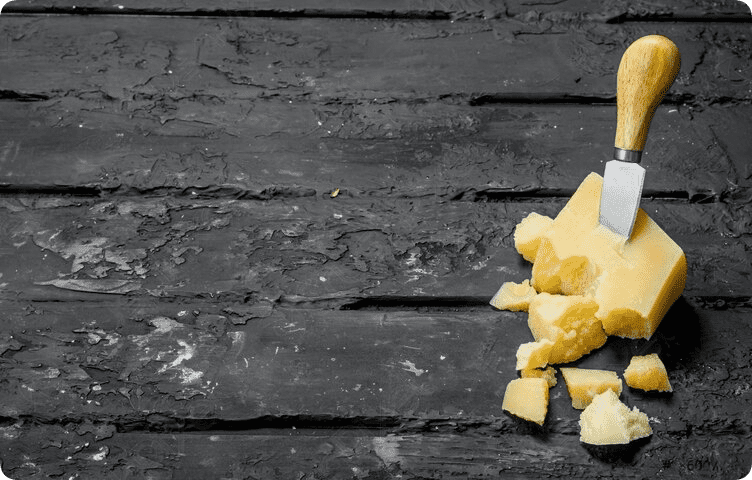
Cheese planes
Externally, the tool looks like a small spatula. The knife blade has a slot with sharp edges. When a spatula is pulled forcefully across a piece of cheese, it “scrapes off” the chips, like a plane. Thin, neat slices come out of the slot. This cutting method is suitable for semi-soft and semi-hard varieties - Roquefort, Munster, Maasdam.
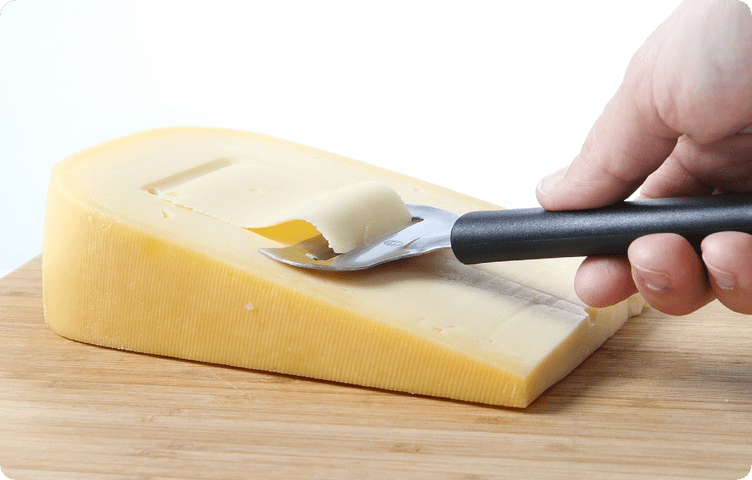
Girol knife for special tasks
This interesting device was originally intended for cutting a single type of cheese - tete de moine. The device is a round stand, in the center of which there is a metal rod with a wide blade attached to it. The cheese head is put on the rod, and then the thinnest shavings are removed with circular movements of the knife.
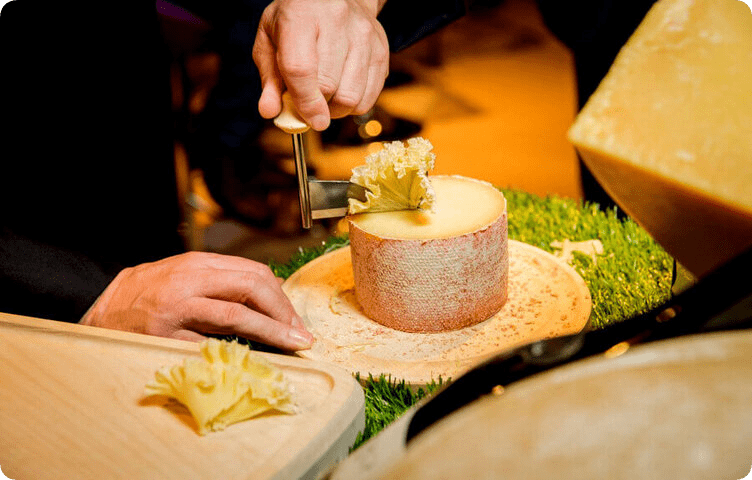
The slices are obtained with wavy edges, reminiscent of chanterelle mushroom plates. This is where the name of the device comes from - “girolle” is translated from French as “chanterelle”. It is used to cut hard cheeses - Edam, Russian, Brebi Basque, and also create chocolate chips for desserts.
Graters and special grinders
Many dishes require shredded cheese rather than slices. You can get it using various types of graters, including:
- manual - resemble a spatula with a short handle and a blade with holes;
- rotary – designed on the principle of a meat grinder. Rotating the handle allows you to turn the product into small chips;
- mechanical - can resemble in shape pepper mills, garlic choppers, miniature meat grinders. They help you quickly grate a large amount of cheese without much effort.
- electric – they are distinguished by a variety of designs and functions, capable of grinding products of varying degrees of hardness.
Mechanical and electric graters are universal devices that should easily process fruits, nuts, and chocolate.
What to consider when choosing a cheese knife
When choosing a tool in a store, pay attention to four factors:
- type - if you prefer specific types of product, choose the product that will be easiest to cut. If you like to try different cheeses, buy a set of 3-4 knives;
- material – the best knife blades are made from stainless steel. A good option for home kitchens is high-carbon steel;
- ergonomics – make sure that the handle of the product is comfortable. Give preference to handles made of natural wood;
- design – the shape and design of products are thought out for specific functions. Extra details and decorations can interfere with your work, so choose laconic products.
How to use a cheese knife
Slicing rules depend on the type of product. If it is a hard type, use the classic version with holes in the blade. First, the tip is inserted into the cheese, then the blade is pressed down evenly.
When cutting semi-hard varieties, the knife is held parallel to the cutting board. Press evenly from top to bottom to separate the slices. If the pressure on the handle is not enough, you can lightly press the tip of the blade with your second hand.
When slicing a very fresh product, the blade is first moistened with a damp towel. To remove the hard rind, first cut it with a cheese saw, then bend it to the side.
For soft cheeses, use a spatula with a pointed edge. Holding the tool vertically, pierce the cheese block in one motion. Using smooth downward movements, separate the slices.
Important tips for care and storage
To ensure that the tool always remains sharp, it is necessary to sharpen it regularly. Once a year, take your knives to a professional sharpener for processing on a special machine.
Blades should only be washed by hand after each use. Immediately after washing, the product is wiped dry with a towel and placed in a stand. If the set comes with a wooden case, it can be used as a permanent storage place.
While slicing cheese, wipe the blade with a damp towel from time to time. This will make the work easier and prevent metal oxidation.
















































/https%3A%2F%2Fcomplexbar.com%2Fimages%2Fblog%2F58%2Fnozhi-dlya-syra.png)
/https%3A%2F%2Fcomplexbar.com%2Fimages%2Fblog%2F245%2Fskov_glavn.jpeg)
/https%3A%2F%2Fcomplexbar.com%2Fimages%2Fblog%2F245%2Fhaiboli.jpg)
/https%3A%2F%2Fcomplexbar.com%2Fimages%2Fblog%2F245%2Fvilki-na-stole-752x480.jpeg)
/https%3A%2F%2Fcomplexbar.com%2Fimages%2Fblog%2F246%2F2024-04-09_17.22.54.jpg)
/https%3A%2F%2Fcomplexbar.com%2Fimages%2Fblog%2F246%2F2024-04-09_17.22.47.jpg)
/https%3A%2F%2Fcomplexbar.com%2Fimages%2Fblog%2F246%2FCODE_anons_foamydrops_752%D1%85480_eng.jpg)
/https%3A%2F%2Fcomplexbar.com%2Fimages%2Fblog%2F246%2FAlina_752%D1%85480_eng.jpg)
/https%3A%2F%2Fcomplexbar.com%2Fimages%2Fblog%2F246%2F2024-04-09_17.23.22.jpg)
/https%3A%2F%2Fcomplexbar.com%2Fimages%2Fblog%2F246%2F2024-04-09_17.23.28.jpg)
/https%3A%2F%2Fcomplexbar.com%2Fimages%2Fblog%2F246%2F2024-04-09_17.23.35.jpg)
/https%3A%2F%2Fcomplexbar.com%2Fimages%2Fblog%2F246%2Fdrinksome_752%D1%85480_eng.jpg)
/https%3A%2F%2Fcomplexbar.com%2Fimages%2Fblog%2F246%2Fnude_752%D1%85480_eng.jpg)
/https%3A%2F%2Fcomplexbar.com%2Fimages%2Fblog%2F246%2F752%D1%85480_eng__1_.jpg)
/https%3A%2F%2Fcomplexbar.com%2Fimages%2Fblog%2F246%2F752%D1%85480_eng.jpg)
/https%3A%2F%2Fcomplexbar.com%2Fimages%2Fblog%2F246%2FStudioRaw_752%D1%85480_eng.jpg)
/https%3A%2F%2Fcomplexbar.com%2Fimages%2Fblog%2F246%2FDoppio_tea_752%D1%85480_eng.jpg)
/https%3A%2F%2Fcomplexbar.com%2Fimages%2Fblog%2F246%2FTognana_Stars_Stripes_752%D1%85480_eng.jpg)
/https%3A%2F%2Fcomplexbar.com%2Fimages%2Fblog%2F246%2FRona_752%D1%85480_eng.jpg)
/https%3A%2F%2Fcomplexbar.com%2Fimages%2Fblog%2F246%2FDoppio_vending_752%D1%85480_eng.jpg)
/https%3A%2F%2Fcomplexbar.com%2Fimages%2Fblog%2F246%2FEssence_sukhie_smesi_752%D1%85480_eng.jpg)
/https%3A%2F%2Fcomplexbar.com%2Fimages%2Fblog%2F246%2FODK_sukhie_smesi752%D1%85480_eng.jpg)
/https%3A%2F%2Fcomplexbar.com%2Fimages%2Fblog%2F246%2Funiforma-barmena.jpg)
/https%3A%2F%2Fcomplexbar.com%2Fimages%2Fblog%2F246%2Fkak-nanyat-barmena.jpg)
/https%3A%2F%2Fcomplexbar.com%2Fimages%2Fblog%2F246%2Fsirop_scale_2400.jpeg)
/https%3A%2F%2Fcomplexbar.com%2Fimages%2Fblog%2F246%2FPeugeot_Anons_Paris_U%27Select_Line_Daman_752%D1%85480_eng.jpg)
/https%3A%2F%2Fcomplexbar.com%2Fimages%2Fblog%2F246%2Fkofe-vostochniy.jpg)
/https%3A%2F%2Fcomplexbar.com%2Fimages%2Fblog%2F246%2FMadler.jpg)
/https%3A%2F%2Fcomplexbar.com%2Fimages%2Fblog%2F246%2Fprofbartender_glavn.jpeg)